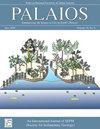PRESERVATION AND HOST PREFERENCES OF LATE FRASNIAN (LATE DEVONIAN) SKELETOBIONTS IN THE APPALACHIAN FORELAND BASIN, USA
IF 1.5
4区 地球科学
Q2 GEOLOGY
引用次数: 1
Abstract
Abstract: Skeletobionts, organisms that attach to or bore into the skeleton of a host, provide a useful system to observe biological interactions over geological timescales. We examined skeletobionts on brachiopod hosts from a stratigraphic section in western New York State that spanned the Lower Kellwasser and Upper Kellwasser events, the two pulses of the Frasnian–Famennian (Late Devonian) mass extinction. The fossils are largely preserved as molds, and even endoskeletobiont borings are often visible with minimal preparation. At least seven major groups of skeletobiont are present including microconchids, stenolaemate and ctenostome bryozoans, hederelloids, and various borings attributed to sponges. The total frequency of skeletobiosis declined significantly across the first extinction pulse (Lower Kellwasser Event), and relative abundance patterns shifted, although the biotic and/or abiotic drivers of these changes require further study. Multivariable logistic regression indicates that large host body size was a strong and consistent predictor of skeletobiosis. Endoskeletobionts were more common in coarser lithologies, reflecting either an ecological preference for sands over muds or a bias against preservation in mudstones. Endoskeletobionts were also more common on ribbed/costate host shells.美国阿巴拉契亚前陆盆地晚FRASNIAN(晚泥盆纪)骨骼生物的保存与寄主偏好
摘要:骨生物是附着在宿主骨架上或钻进宿主骨架的生物,为观察地质时间尺度上的生物相互作用提供了一个有用的系统。我们在纽约州西部的一个地层剖面上研究了腕足类宿主上的骨骼生物,该剖面跨越了下Kellwasser和上Kellwasser事件,这是frasian - famenian(晚泥盆世)大灭绝的两个脉冲。这些化石大多以霉菌的形式保存下来,即使是内骨骼生物的钻孔也经常在很少的准备下就能看到。至少有7种主要的骨骼生物存在,包括微贝壳、窄孔虫和栉孔虫、蛭形线虫和各种归因于海绵的无聊虫。在第一次灭绝脉冲(Lower Kellwasser事件)中,骨化的总频率显著下降,相对丰度模式发生了变化,尽管这些变化的生物和/或非生物驱动因素需要进一步研究。多变量逻辑回归表明,大的宿主体型是一个强有力的和一致的预测骨骼增生。内骨骼生物在较粗糙的岩性中更常见,这反映了对砂的生态偏好,而不是泥浆,或者是对泥岩保存的偏好。内骨骼生物在肋状/羽状宿主壳上也更常见。
本文章由计算机程序翻译,如有差异,请以英文原文为准。
求助全文
约1分钟内获得全文
求助全文
来源期刊

Palaios
地学-地质学
CiteScore
2.80
自引率
12.50%
发文量
40
审稿时长
6 months
期刊介绍:
PALAIOS is a monthly journal, founded in 1986, dedicated to emphasizing the impact of life on Earth''s history as recorded in the paleontological and sedimentological records. PALAIOS disseminates information to an international spectrum of geologists and biologists interested in a broad range of topics, including, but not limited to, biogeochemistry, ichnology, paleoclimatology, paleoecology, paleoceanography, sedimentology, stratigraphy, geomicrobiology, paleobiogeochemistry, and astrobiology.
PALAIOS publishes original papers that emphasize using paleontology to answer important geological and biological questions that further our understanding of Earth history. Accordingly, manuscripts whose subject matter and conclusions have broader geologic implications are much more likely to be selected for publication. Given that the purpose of PALAIOS is to generate enthusiasm for paleontology among a broad spectrum of readers, the editors request the following: titles that generate immediate interest; abstracts that emphasize important conclusions; illustrations of professional caliber used in place of words; and lively, yet scholarly, text.
 求助内容:
求助内容: 应助结果提醒方式:
应助结果提醒方式:


